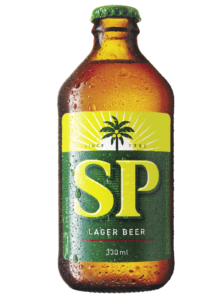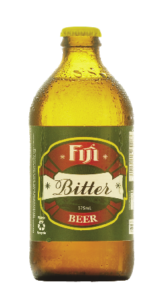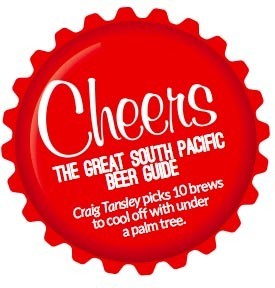10 brews to cool off with under a palm tree, reviewed by Craig Tansley.
We know the South Pacific is home to some of the world’s most exotic islands and it’s where you’ll find the prettiest lagoons on Earth.
But what about the beer? In this guide, we pop the top off 10 of the most noteable beers to provide these considered tasting notes. Well, somebody had to do it!
South Pacific (SP), Papua New Guinea 
Somehow you’d think a beer from a country as wild as Papua New Guinea might taste a bit more rugged – but of all the beers in the Pacific this is the beer that tastes the most Japanese – refined, light, dry, hopsy and only mildly bitter. It’s been around since 1951 but was recently taken over by Heineken, which invested over $100 million in it, including plans to export it to parts of Australia and New Zealand. So you might see it around the place a lot more soon – which is fine by me since it epitomises the tropical lager.
Hinano, Tahiti 
You haven’t arrived in Tahiti till you’re drinking an ice-cold Hinano beside a blue lagoon. It’s all everyone drinks in Tahiti. With its light, golden colouring, Hinano’s got that Corona kind of thing going for afternoon drinking. But there’s something more complex about it: it has a bitter after-taste that means it’s not as flimsy as some lagers can be. It’s not only Tahitians who love the stuff: in 1993 Hinano won Best International Beer at the prestigious Luxembourg beer awards. It’s also got the best beer label in the Pacific – a vahine in a sarong beside a lagoon.
Vailima, Samoa
Perhaps there’s a nod to Samoa’s former rulers (Samoa was the only German colony in the Pacific) but you’ll notice how much Vailima tastes like a German lager from the moment you … well … taste it. The hops used are from Germany, and the government originally set up the brewery with German partners. But it’s a nice change to many Pacific lagers – it’s more malty than most. It’s hard to find a Vailima outside Samoa – but that means drinking your first one in Samoa tastes even better. It’s the prototype for a tropical beer – light, refreshing with a cleansing aftertaste that doesn’t scream hangover.
Tusker, Vanuatu
It’s a beer that’s got better with the times. People used to call it flat, thin and bland. But these days the design of the beer label’s not the only thing that’s improved – the beer’s gotten spicier giving just the amount of kick to wash down Vanuatu’s famous kava (the Pacific’s strongest, or so they say), or to toast another hot sunny day on the lagoon. It’s a lighter tasting lager which makes it ideal for afternoon sipping. The great thing about Tusker is it’s not just for tourists – it’s a working-class beer for the people that still doesn’t look out of place in Vanuatu’s finest restaurants.
Vonu, Fiji 
Vonu’s slogan “Pure Fiji Rainwater Turned Into Beer” is a clever one, and combined with its swanky bottle design you can’t help feeling Vonu will taste clean and crisp just by looking at it. The good news it does, but there’s more going for it too; it’s darker than most pale lagers, it’s halfway between a pale and an amber lager and you can taste the difference. There’s more malt, mixed with a little fruit – like you might expect in a wheat beer. Little wonder Coca-Cola bought the brand two years ago to try market it outside Fiji.
Matutu, Cook Islands
In the old days, if you wanted a locally brewed beer in the Cooks the only choice was Cooks Lager. It was cheap and not highly regarded – as high as 6.5 per cent in alcohol content, with some batches of beer often burnt. Locals haven’t shown the same loyalty for Matutu (probably because it’s premium priced), but visitors love the stuff. Brewed by two families of locals who returned to Rarotonga, the lager is made from German Pilsner malt, and four hops are added to give it a little more oomph. It might be only five years old but it’s fast become the beer of the Cooks.
Number One, New Caledonia
Surely it’s that renowned French confidence that prompted the naming of Number One lager in one of France’s two Pacific outposts, New Caledonia. While Number One is indeed number one in New Caledonia, for me it doesn’t quite rate alongside the Hinanos, Matutus and Vailimas of the Pacific. Produced these days by Heineken’s Asia Pacific operation, at least you know the quality’s there in each batch. It’s an American pale lager-style beer that’s got a sweet kind of smell about it but the taste is quite bitter.
Fiji Bitter, Fiji
This is the beer of the Fijian people – it has over 90 per cent of the market share in Fiji. But there’s something about its dull green label and its generic kind of Aussie lager taste that makes you draw parallels to Australia’s middle-of-the-road, blue-collar favourite, VB. You almost expect it to carry the same slogan: “for a hard-earned thirst”. The slogan would work, because the beer’s low carbonation and its hints of fruit satisfy even the driest throat. But it’s not likely to be a beer you’ll miss, and besides, you can always take home the singlet.
SolBrew, Solomon Islands 
They say in the Solomons you can have any beer you like as long as it’s SolBrew. It’s worshipped there; so much so that Heineken figured it would gain a majority stake in the 21-year-old brewer just to see what all the fuss was about. Pacific islanders tend to be parochial about beer, but it borders on fanaticism here. It’s a good beer, too – grassier than most lagers, it tastes almost healthy with a hint of earthy vegetables. But there’s a tartness to it, too, that I reckon really comes out with lime added (though don’t let locals catch you, it’s considered treason to mess with Solbrew).
Matso’s Smokey Bishop Dark Lager, Australia
Brewed on-site at one of the Pacific’s most iconic old buildings in the former red-light district of the pearling town of Broome, ironically this lager’s named after a local clergyman who was fond of a tipple. The Matso’s microbrewery makes seven other beers – and two ciders – and you can see why together they’ve won so many of Australia’s brewingawards. The Dark Lager’s only made in small batches so alot of love and effort goes into each bottle. You’d think a beer with chocolate and coffee notes mightn’t work in the tropics. Don’t think, just drink, ’cause it does. It’s magic, Kimberley style.

